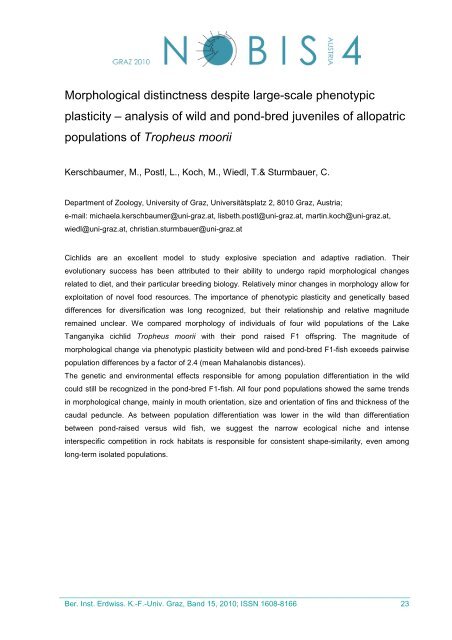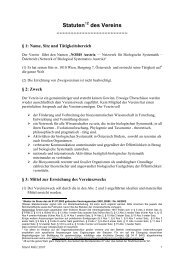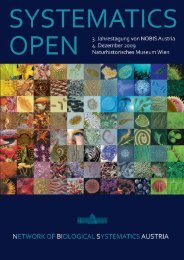4. Jahrestagung von NOBIS Austria 2. - 3. Dezember 2010
4. Jahrestagung von NOBIS Austria 2. - 3. Dezember 2010
4. Jahrestagung von NOBIS Austria 2. - 3. Dezember 2010
Create successful ePaper yourself
Turn your PDF publications into a flip-book with our unique Google optimized e-Paper software.
Morphological distinctness despite large-scale phenotypic<br />
plasticity – analysis of wild and pond-bred juveniles of allopatric<br />
populations of Tropheus moorii<br />
Kerschbaumer, M., Postl, L., Koch, M., Wiedl, T.& Sturmbauer, C.<br />
Department of Zoology, University of Graz, Universitätsplatz 2, 8010 Graz, <strong>Austria</strong>;<br />
e-mail: michaela.kerschbaumer@uni-graz.at, lisbeth.postl@uni-graz.at, martin.koch@uni-graz.at,<br />
wiedl@uni-graz.at, christian.sturmbauer@uni-graz.at<br />
Cichlids are an excellent model to study explosive speciation and adaptive radiation. Their<br />
evolutionary success has been attributed to their ability to undergo rapid morphological changes<br />
related to diet, and their particular breeding biology. Relatively minor changes in morphology allow for<br />
exploitation of novel food resources. The importance of phenotypic plasticity and genetically based<br />
differences for diversification was long recognized, but their relationship and relative magnitude<br />
remained unclear. We compared morphology of individuals of four wild populations of the Lake<br />
Tanganyika cichlid Tropheus moorii with their pond raised F1 offspring. The magnitude of<br />
morphological change via phenotypic plasticity between wild and pond-bred F1-fish exceeds pairwise<br />
population differences by a factor of <strong>2.</strong>4 (mean Mahalanobis distances).<br />
The genetic and environmental effects responsible for among population differentiation in the wild<br />
could still be recognized in the pond-bred F1-fish. All four pond populations showed the same trends<br />
in morphological change, mainly in mouth orientation, size and orientation of fins and thickness of the<br />
caudal peduncle. As between population differentiation was lower in the wild than differentiation<br />
between pond-raised versus wild fish, we suggest the narrow ecological niche and intense<br />
interspecific competition in rock habitats is responsible for consistent shape-similarity, even among<br />
long-term isolated populations.<br />
_____________________________________________________________________________<br />
Ber. Inst. Erdwiss. K.-F.-Univ. Graz, Band 15, <strong>2010</strong>; ISSN 1608-8166 23






